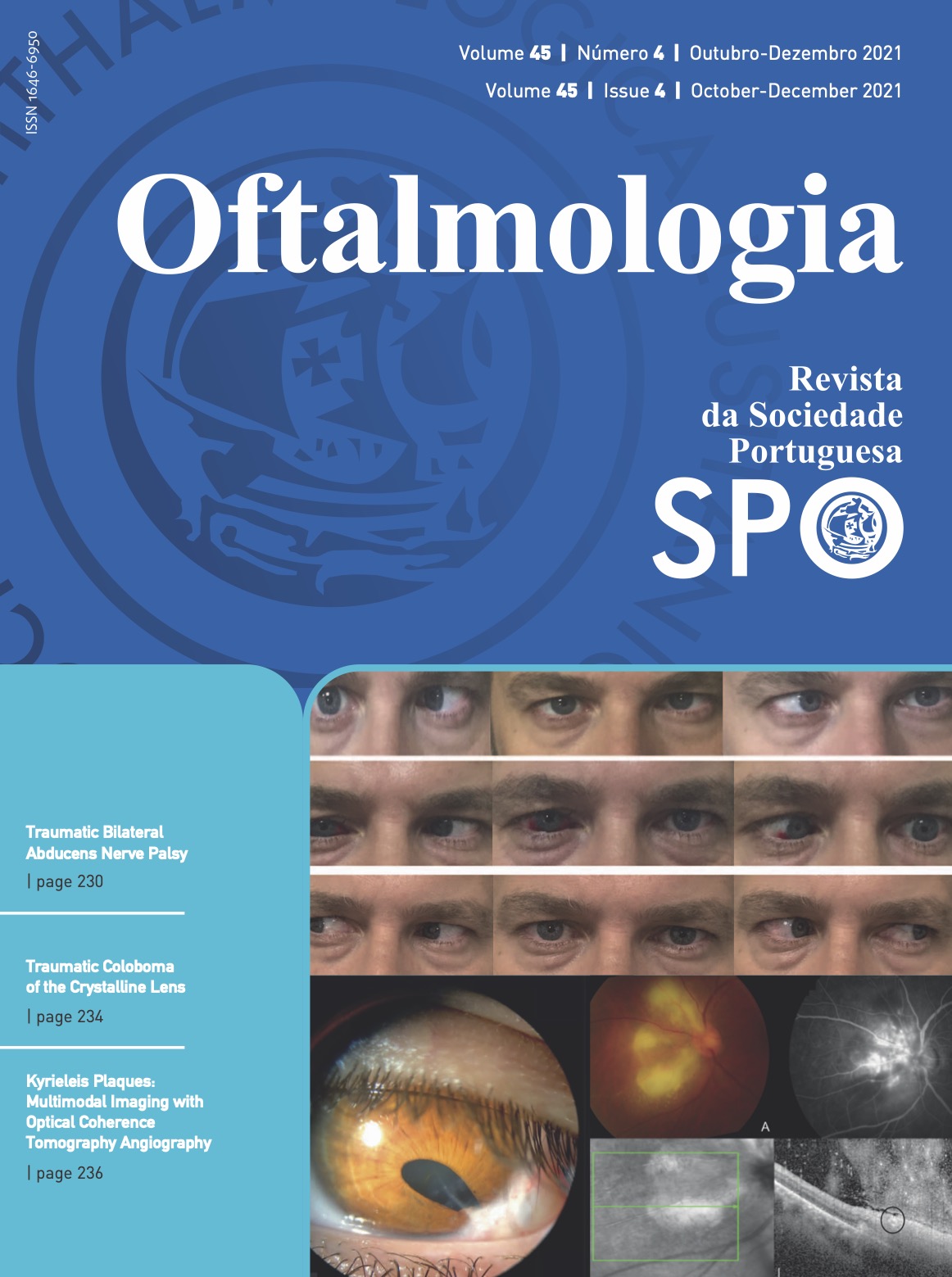Autofluorescência do fundo ocular: dos princípios básicos às aplicações clínicas
DOI:
https://doi.org/10.48560/rspo.24546Palavras-chave:
Angiofluoresceinografia, Degenerescência Macular, Doenças Retinianas, Fundo de OlhoResumo
A autofluorescência do fundo ocular (FAF) é um exame de imagem valioso em várias doenças da retina, que poderá ser subutilizado na prática clínica diária. O objectivo deste artigo é rever os princípios básicos da autofluorescência azul e realçar sua utilidade clínica.
A FAF é um exame de imagem não invasivo e rápido do fundo ocular. As imagens de FAF reflectem a distribuição da lipofuscina no epitélio pigmentar da retina (RPE), permitindo uma avaliação da sua função e a detecção de zonas de atrofia. Existem vários sistemas de aquisição de FAF, resultando em diferenças qualitativas e quantitativas que devem ser consideradas aquando da interpretação das imagens. Numerosas doenças do fundo ocular apresentam alterações no sinal de autofluorescência. Algumas apresentam padrões típicos de autofluorescência que auxiliam no seu diagnóstico, nomeadamente a degeneração macular ligada à idade (AMD), doenças hereditárias da retina, coriorretinopatias inflamatórias e retinopatia pelos antimaláricos. Nos últimos anos, vários estudos têm demonstrado o papel da FAF na monitorização e no prognóstico de várias doenças, sobretudo na área da AMD.
A FAF é uma modalidade de imagem útil para fins de diagnóstico, mas também para a monitorização de várias doenças retinianas. Deve-se considerar a sua incorporação na avaliação de rotina de doentes com AMD, entre outros.
Downloads
Referências
Sepah YJ, Akhtar A, Sadiq MA, Hafeez Y, Nasir H, Perez B, et al. Fundus autofluorescence imaging: Fundamentals and clinical relevance. Saudi J Ophthalmol. 2014;28:111-6. doi: 10.1016/j.sjopt.2014.03.008.
Yung M, Klufas M, Sarraf D. Clinical applications of fundus autofluorescence in retinal disease. Int J Retina Vitreous. 2016;2:12. doi: 10.1186/s40942-016-0035-x.
Keilhauer C, Delori F. Near-infrared autofluorescence imaging of the fundus: visualization of ocular melanin. Ophthalmol Vis Sci. 2006;47:3556-64. doi: 10.1167/iovs.06-0122.
Skondra D, Papakostas T, Hunter R, Vavvas D. Near infrared autofluorescence imaging of retinal diseases. Semin Ophthalmol. 2012;27:202-8. doi: 10.3109/08820538.2012.708806.
Calvo-Maroto A, Esteve-Taboada J, Domínguez-Vicent A, Pérez-Cambrodí R, Cerviño A. Confocal scanning laser ophthalmoscopy versus modified conventional fundus camera for fundus autofluorescence. Expert Rev Med Devices. 2016;13:965-78. doi: 10.1080/17434440.2016.1236678.
Park S, Siringo F, Pensec N, Hong I, Sparrow J, Barile G, et al. Comparison of fundus autofluorescence between fundus camera and confocal scanning laser ophthalmoscope-based systems. Ophthalmic Surg Lasers Imaging Retina. 2013;44:536-43. doi: 10.3928/23258160-20131105-04.
Patel S, Shi A, Wibbelsman T, Klufas M. Ultra-widefield retinal imaging: an update on recent advances. Ther Adv Ophthalmol. 2020;12:2515841419899495. doi: 10.1177/2515841419899495.
Landa G, Rosen R, Pilavas J, Garcia P. Drusen characteristics revealed by spectral-domain optical coherence tomography and their corresponding fundus autofluorescence appearance in dry age-related macular degeneration. Ophthalmic Res. 2012;47:81-6. doi: 10.1159/000324988.
Bindewald A, Bird A, Dandekar S, Dolar-Szczasny J, Dreyhaupt J, Fitzke F, et al. Classification of fundus autofluorescence patterns in early age-related macular disease. Invest Ophthalmol Vis Sci. 2005;46:3309-14. doi: 10.1167/iovs.04-0430.
Batioğlu F, Demirel S, Ozmert E, Oguz Y, Ozyol P. Autofluorescence patterns as a predictive factor for neovascularization. Optom Vis Sci. 2014;91:950-5. doi: 10.1097/OPX.0000000000000321.
Ly A, Nivison-Smith L, Assaad N, Kalloniatis M. Fundus Autofluorescence in age-related macular degeneration. Optom Vis Sci. 2017 Feb;94(2):246-259. doi: 10.1097/OPX.0000000000000997.
Conti T, Ohlhausen M, Hom G, Talcott K, Golshani C, Choudhry N, et al. Comparison of widefield imaging between confocal laser scanning ophthalmoscopy and broad line fundus imaging in routine clinical practice. Ophthalmic Surg Lasers Imaging Retina. 2020;51:89-94. doi: 10.3928/23258160-20200129-03.
Wolf-Schnurrbusch U, Wittwer V, Ghanem R, Niederhaeuser M, Enzmann V, Framme C, et al. Blue-light versus green-light autofluorescence: lesion size of areas of geographic atrophy. Invest Ophthalmol Vis Sci. 2011;52:9497-502. doi: 10.1167/iovs.11-8346.
Holz F, Bindewald-Wittich A, Fleckenstein M, Dreyhaupt J, Scholl H, Schmitz-Valckenberg S. Progression of geographic atrophy and impact of fundus autofluorescence patterns in age-related macular degeneration. Am J Ophthalmol. 2007;143:463-72. doi: 10.1016/j.ajo.2006.11.041.
Batıoğlu F, Gedik OY, Demirel S, Ozmert E. Geographic atrophy progression in eyes with age-related macular degeneration: role of fundus autofluorescence patterns, fellow eye and baseline atrophy area. Ophthalmic Res. 2014;52:53-9. doi: 10.1159/000361077.
McBain V, Townend J, Lois N. Fundus autofluorescence in exudative age-related macular degeneration. Br J Ophthalmol. 2007;91:491-6. doi: 10.1136/bjo.2006.095109.
Camacho N, Barteselli G, Nezgoda J, El-Emam S, Cheng L, Bartsch D, et al. Significance of the hyperautofluorescent ring associated with choroidal neovascularisation in eyes undergoing anti-VEGF therapy for wet age-related macular degeneration. Br J Ophthalmol. 2015;99:1277-83. doi: 10.1136/bjophthalmol-2014-306226.
Sawa M, Ober M, Spaide R. Autofluorescence and retinal pigment epithelial atrophy after subretinal hemorrhage. Retina. 2006;26:119-20. doi: 10.1097/00006982-200601000-00025.
Gabai A, Veritti D, Lanzetta P. Fundus autofluorescence applications in retinal imaging. Indian J Ophthalmol. 2015;63:406-15. doi: 10.4103/0301-4738.159868.
von Rückmann A, Fitzke F, Fan J, Halfyard A, Bird A. Abnormalities of fundus autofluorescence in central serous retinopathy. Am J Ophthalmol. 2002;133:780-6. doi: 10.1016/s0002-9394(02)01428-9.
Boon C, Jeroen KB, Keunen J, Hoyng C, Theelen T. Fundus autofluorescence imaging of retinal dystrophies. Vision Res. 2008;48:2569-77. doi: 10.1016/j.visres.2008.01.010.
Oishi A, Miyata M, Numa S, Otsuka Y, Oishi M, Tsujikawa A. Wide-field fundus autofluorescence imaging in patients with hereditary retinal degeneration: a literature review. Int J Retina Vitreous. 2019;5(Suppl 1):23. doi: 10.1186/s40942-019-0173-z.
Fleckenstein M, Charbel IP, Fuchs H, Finger R, Helb H, Scholl H, et al. Discrete arcs of increased fundus autofluorescence in retinal dystrophies and functional correlate on microperimetry. Eye. 2009;23:567-75. doi: 10.1038/eye.2008.59
Querques G, Zerbib J, Georges A, Massamba N, Forte R, Querques L, et al. Multimodal analysis of the progression of Best vitelliform macular dystrophy. Mol Vis. 2014;20:575-92.
Parodi M, Iacono P, Campa C, Del Turco C, Bandello F. Fundus autofluorescence patterns in Best vitelliform macular dystrophy. Am J Ophthalmol. 2014;158:1086-92. doi: 10.1016/j.ajo.2014.07.026.
Pandya H, Robinson M, Mandal N, Shah V. Hydroxychloroquine retinopathy: A review of imaging. Indian J Ophthalmol. 2015;63:570-4. doi: 10.4103/0301-4738.167120.
Marmor M, Kellner U, Lai T, Melles R, Mieler W. Recommendations on Screening for Chloroquine and Hydroxychloroquine Retinopathy (2016 Revision). Ophthalmology. 2016;123:1386-94. doi: 10.1016/j.ophtha.2016.01.058.
Yusuf I, Sharma S, Luqmani R, Downes S. Hydroxychloroquine retinopathy. Eye. 2017;31:828-45. doi: 10.1038/eye.2016.298.
Raven M, Ringeisen A, Yonekawa Y, Stem M, Faia L, Gottlieb J. Multi-modal imaging and anatomic classification of the white dot syndromes. Int J Retina Vitreous. 2017;3:12. doi: 10.1186/s40942-017-0069-8.
Meleth A, Sen H. Use of fundus autofluorescence in the diagnosis and management of uveitis. Int Ophthalmol Clin. 2012;52:45-54. doi: 10.1097/IIO.0b013e3182662ee9.
Yeh S, Forooghian F, Wong W, Faia L, Cukras C, Lew J, et al. Fundus autofluorescence imaging of the white dot syndromes. Arch Ophthalmol. 2010;128:46-56. doi: 10.1001/archophthalmol.2009.368.
Palmer E, Gale J, Crowston J, Wells A. Optic Nerve Head Drusen: An Update. Neuroophthalmology. 2018;42:367-84. doi: 10.1080/01658107.2018.1444060.
Downloads
Publicado
Como Citar
Edição
Secção
Licença
Direitos de Autor (c) 2021 Revista Sociedade Portuguesa de Oftalmologia

Este trabalho encontra-se publicado com a Creative Commons Atribuição-NãoComercial 4.0.
Não se esqueça de fazer o download do ficheiro da Declaração de Responsabilidade Autoral e Autorização para Publicação e de Conflito de Interesses
O artigo apenas poderá ser submetido com esse dois documentos.
Para obter o ficheiro da Declaração de Responsabilidade Autoral, clique aqui
Para obter o ficheiro de Conflito de Interesses, clique aqui





